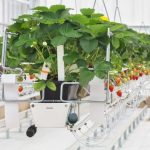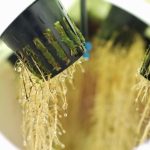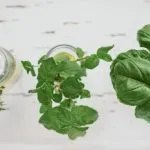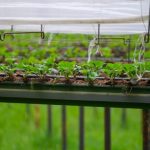Aeroponics gardening is an innovative method of growing plants that allows you to take control of their environment, ultimately optimizing their growth and health. This advanced variation of hydroponics involves suspending plants in the air, with their roots exposed, and periodically misting them with nutrient-rich water vapor. With its space-saving nature and efficient use of resources, aeroponics provides a fantastic alternative for cultivating plants, particularly in small or indoor areas.
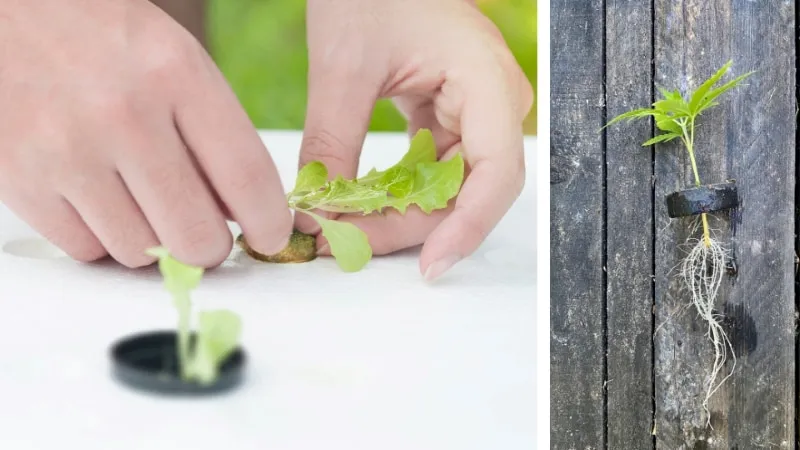
What is aeroponics gardening and is it different from hydroponics? In contrast to hydroponics, where coco coir, perlite, etc. serve as the growing medium, aeroponics gardening eliminates the need for any medium altogether. This not only keeps your plants’ roots oxygenated and thriving but also reduces the potential for pests and diseases. By carefully monitoring nutrient levels and environmental conditions such as temperature, humidity, and light, you can create an optimal setting for your plants to flourish.
So, how does aeroponics work? Nutrients are delivered directly to the plants’ roots through a timed sprinkler system or misting mechanism. Since the roots are exposed and highly absorbent, they take in the essential minerals quickly and efficiently. This innovative approach results in faster growth rates, higher yields, and allows you to grow a wide variety of plants without the need for soil, making aeroponics gardening an exciting and rewarding endeavor for any green-thumbed enthusiast.
- History of Aeroponics
- How Does Aeroponics Work: Basic Principles of an Aeroponics Garden
- Aeroponic System Diagram
- Components of an Aeroponic System
- Types of Aeroponic Systems
- Where Is Aeroponics Used?
- Growing Tips for Successful Aeroponics Gardening
- Troubleshooting and Maintenance
- Frequently Asked Questions
History of Aeroponics
Who invented aeroponics? The concept of aeroponics dates back to the 1920s but didn’t gain popularity as a method for growing plants until the 1980s. Before that, it was mainly an academic study waiting for implementation into commercial and hobby farming. The idea of growing plants without soil was a foreign concept to most people at that time. This technique was first proposed by Dr. Richard J. Stoner II in the early 1980s. He developed it further and patented the process, making significant contributions to the field of aeroponics.
The term aeroponics, which has its roots in the Greek words for air “aer” and labor “ponos,” meaning “working air,” is a subset of hydroponics. It involves growing plants without the use of soil, relying on air to deliver a nutrient-rich mist to the plant’s roots. This method allows plants to grow in a cleaner environment, making them less prone to diseases and pests.
The first aeroponics system was introduced as part of NASA’s research on space gardening in the 1990s. They began experimenting in 1997, planting adzuki beans and seedlings aboard the Mir space station in zero gravity. These space-grown plants were then compared to controlled aeroponic gardens on Earth. The results showed that aeroponics could be an effective way to grow food in space, paving the way for the development of more advanced systems.
In recent years, aeroponics has become more mainstream, benefiting from the increased interest in urban and vertical farming, as well as the desire for more sustainable and efficient agricultural practices. This unique method of gardening provides an opportunity for you to grow plants without the need for soil, making it an innovative alternative, especially in areas with limited access to arable land or traditional farming resources.
The meaning of aeroponics becomes clearer as you delve into its history and how it has evolved over the years. It’s a wonderful fusion between science and nature, aiming to provide sustainable and efficient gardening options for a variety of settings. Now that you know more about its origins, you can better appreciate the value and potential of this groundbreaking approach to the world of gardening.
How Does Aeroponics Work: Basic Principles of an Aeroponics Garden
In aeroponics gardening, the methodology of aeroponics involves growing plants by suspending their roots in a nutrient-rich mist, instead of soil or other growing mediums. This unique approach provides various benefits, such as faster growth and reduced water usage. Here’s a comprehensive list of the benefits of aeroponics.
The crucial components of aeroponic systems include a nutrient solution, pump, and misting nozzles. Your plants will be placed in specialized containers, leaving the roots exposed. The nutrient solution, which contains essential minerals and vitamins, is stored in a reservoir.
At regular intervals, a pump is used to deliver the nutrient-rich mist to the exposed roots of your plants through the misting nozzles. This mist will provide the required nutrients and oxygen for optimal plant growth. Since the roots are not hindered by soil or a growing medium, they have more access to oxygen, resulting in faster growth.
One important aspect of aeroponics gardening is the routine monitoring of pH and nutrient levels in the nutrient solution. You need to ensure that the plants get accurate and optimal nutrients for their development. Additionally, a timer is often used to control the frequency and duration of the misting process to prevent over or under-watering.
To keep your aeroponic system functioning smoothly, ensure that the misting nozzles are clean and free from clogs. This maintenance is necessary to prevent any malfunctions that might affect plant growth.
Related: Here’s an overall guide and introduction to all the other hydroponic systems.
Aeroponic System Diagram
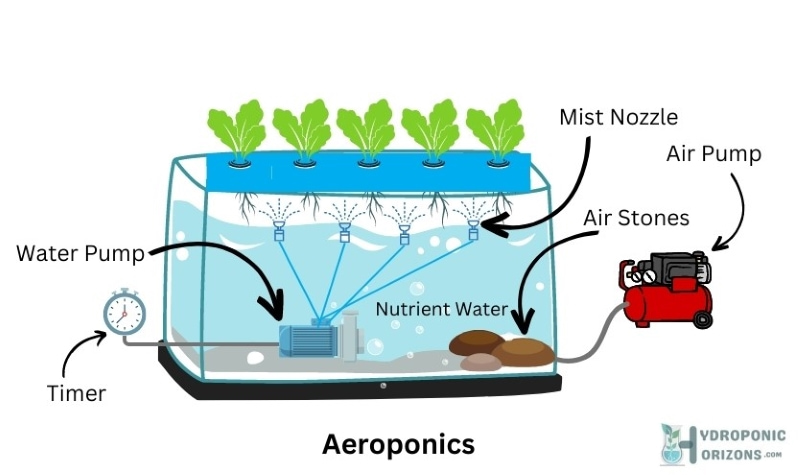
Components of an Aeroponic System
Aeroponic gardening involves growing plants in a nutrient-rich mist without the need for soil. To set up a successful aeroponic system, there are several essential components that must be in place. In this section, we’ll discuss the key parts of an aeroponic system, including the reservoir, misters, pumps, and soilless growing medium.
Reservoir
The reservoir is where the nutrient solution and water are stored, ready to be delivered to your plants. Be sure to maintain the water level and keep an eye on the nutrient concentration. Your plants depend on this reservoir for their essential minerals and hydration, so maintain the right balance of nutrients and have fresh water to ensure optimal growth.
Misters
In an aeroponic system, misters are responsible for delivering water and nutrients directly to your plant roots, which are suspended in the air. The misters spray a fine mist that keeps the roots moisturized and provides them with the essential nutrients they need. Since misters are crucial to your plants’ health, ensure they’re functioning effectively, and check for any clogs or debris that may be hindering their performance.
Pumps
Pumps play a critical role in an aeroponic system by circulating the nutrient solution from the reservoir to the misters. A water pump ensures that your plants receive an adequate and consistent supply of nutrients and moisture. It’s essential to choose an appropriate pump based on the size and demands of your aeroponic setup. We recommend a pump timer as well so that the roots benefit from a proper aeroponics watering schedule. Regularly inspect the pump for any issues, like overheating or reduced pressure, to maintain smooth operation.
Soilless Growing Medium or Anchor
Aeroponics eliminates the need for traditional soil, but your plants still need something to anchor them and offer support as they grow. Common soilless growing mediums include foam, peat, and coconut coir. These mediums facilitate your plants’ growth by providing a suitable anchor for roots to grow through and be exposed underneath to absorb misted nutrients. While choosing a soilless medium, consider factors such as water retention, aeration, and the types of plants you’re planning to grow in your aeroponic system.
You may see by now that aeroponics is a more advanced method that is best adopted by someone who has prior hydroponics experience. If you’re a beginner and would like to dip your toes in first before building a aeroponic gardening system, follow our easy guide – Hydroponics for Beginners.
Types of Aeroponic Systems
Low-Pressure
Low-pressure aeroponic systems use a low-pressure pump to deliver the nutrient-rich solution to the plants’ roots via misting nozzles. This type of system is best suited for growing leafy greens and other lightweight plants, since it provides a gentle environment for their roots to grow. The low-pressure system is easier to set up and less expensive compared to high-pressure systems.
High-Pressure
High-pressure aeroponic systems utilize a high-pressure pump to create a finer mist, which allows for improved nutrient absorption. This type of aeroponic system is more efficient in providing nutrients to your plants and is suitable for a wider range of plants, including cucumbers. However, high-pressure systems are more expensive and can be more challenging to set up and maintain due to the increased need for precision in creating the right mist.
Related: Learn more about the differences between low and high pressure aeroponic systems.
Horizontal
A horizontal aeroponic system involves setting up your plants in a horizontal configuration, typically on racks or shelves. In this setup, the nutrient-rich solution is dispersed evenly across the roots of your plants. Horizontal systems are often easier to maintain since all the plants are at the same level, making it simpler to access and monitor them.
Vertical
In a vertical aeroponic system, plants are arranged vertically, either in towers or stacked layers. This design maximizes space utilization and enables you to grow more plants in a limited area. Vertical systems often demonstrate higher yields per square foot, making them an attractive option for urban and commercial applications. Keep in mind that vertical systems generally require more attention to ensure each plant receives an even distribution of nutrient-rich solution. Find out more about how an aeroponics tower works.
Remember, when choosing the type of aeroponic system for your garden, consider factors such as the types of plants you want to grow, available space, and your desired level of maintenance. This will help you to determine the best system that fits your needs and goals.
Related: Find out what plants grow best in aeroponics.
If you’re looking for a vertical system for your home, we can help you find the best aeroponics tower garden kit.
Where Is Aeroponics Used?
Aeroponics gardening is a method in which plants are grown without soil, suspended in the air with their roots exposed and receiving nutrients through a nutrient-rich mist. This innovative technique is used in various locations around the world, both large and small scale. Let’s explore a few notable examples.
One well-known application of aeroponics is at the Chicago O’Hare Airport. In 2011, the airport worked in collaboration with an agricultural company to install an aeroponic garden. This successful initiative has made it one of the most popular aeroponic gardens globally, showcasing the potential and practicality of this method.
Another example includes NASA’s utilization of aeroponic systems in their research, focusing on sustainable food production in space missions. They’re considering aeroponics as a viable method to provide astronauts with fresh produce during extended periods away from Earth. This demonstrates how aeroponics can be applied even in challenging conditions.
In addition, commercial farms have begun to adopt aeroponics for large-scale production of various crops, such as lettuce, herbs, and tomatoes. This method allows farmers to maximize their production while conserving water and reducing the need for pesticides.
Small-scale gardeners can also benefit from aeroponics through home-based systems. Many enthusiasts have adopted this method for growing a wide range of plants, such as vegetables, herbs, and decorative plants, in limited spaces, like apartments, balconies, and outdoor patios.
These examples show that aeroponics is a versatile and adaptable method used in various contexts worldwide, whether it’s a large airport project, in outer space research, or just your own backyard gardening adventures.
Growing Tips for Successful Aeroponics Gardening
To make the most out of your aeroponics system, follow these friendly tips to ensure a successful and thriving garden.
1. Monitor pH levels: Maintaining the appropriate pH level in your nutrient solution is critical for the health of your plants. Aim for a pH range between 5.5 and 6.5 for most plants. Regularly check and adjust the pH levels with a pH meter to ensure optimal nutrient absorption by the plants.
2. Keep an eye on EC readings: Electrical conductivity (EC) is a measure of the nutrient concentration in your solution. Monitor EC levels to make sure your plants receive the right balance of nutrients. Aim for an EC reading between 1.2 and 1.8 mS/cm, depending on the plants you’re growing.
3. Use soilless media or foam rings: Some aeroponic systems still require a soilless growing medium or plugs for plant support, such as perlite, coco coir, or rockwool. Foam rings are a popular choice too. This allows for better air circulation and nutrient uptake, leading to faster growth and healthier plants.
4. Optimize grow light placement: Adequate lighting is essential for photosynthesis and overall plant health. If natural light is not sufficient, use grow lights to provide the necessary spectrum and intensity. Position the lights close to the plants, but not too close to avoid overheating or light burns.
5. Balance natural and artificial light: Utilize both natural and artificial lighting sources if possible. By offering a combination of natural sunlight and grow lights, you can ensure consistent light levels throughout the day, optimizing photosynthesis and growth.
6. Clean your system regularly: To prevent clogging and maintain optimal performance, clean your system regularly. Flush the entire system, including mist nozzles, and replenish the nutrient solution at least once a month. This will help prevent the buildup of algae and harmful bacteria.
Following these tips will help you create a thriving aeroponics garden. Remember to stay vigilant, monitor your system closely, and adjust when necessary to ensure the best environment for your plants.
Troubleshooting and Maintenance
In aeroponics gardening, it’s essential to keep an eye on your system and perform regular maintenance to ensure optimal plant growth. In this section, we will cover some common troubleshooting tips and maintenance tasks to help you keep your aeroponic system running smoothly.
Water droplets play a crucial role in delivering nutrients and oxygen to your plants’ roots. Make sure to monitor the size and distribution of the water droplets created by your misting devices. If you notice an inconsistency in the droplet size or an insufficient mist coverage, clean your misting devices and check for blockages or wear and tear.
Foam rings are commonly used to support your plants as they grow and help secure them in place. Over time, these rings may become worn out or dirty, compromising their effectiveness. Periodically inspect the rings and replace them as needed to ensure your plants receive proper support.
Misting devices require regular cleaning and maintenance to function correctly. Check and clean the nozzles regularly to avoid blockages and ensure the right amount of water and nutrients reaches your plants. Additionally, inspect the device’s water pressure and adjust it as needed to achieve an optimal misting pattern.
Maintaining a controlled environment in your aeroponic system is crucial for plant growth. Make sure your system provides the appropriate amount of light, temperature, and humidity for your plants. Regularly monitor these factors and adjust them accordingly to ensure optimal growing conditions.
During your troubleshooting process, be on the lookout for any signs of nutrient deficiencies, pests, or diseases in your plants. Addressing these issues early on can help prevent further damage and promote healthy growth. Keep a close eye on your plants and system and address any unusual occurrences, such as wilting, yellowing leaves, or unusual growth patterns.
Regular maintenance and troubleshooting will help you identify potential issues and ensure your aeroponic garden thrives. Stay attentive to your system’s needs and make adjustments as needed to provide the best possible environment for your plants.

